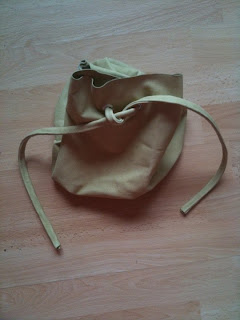This card wrap was created using the university's yarns. I tried to use natural and neutral coloured yarns. In the photograph above you can see, from left to right, how the yarns are smooth and rough. The yarns also vary in thickness. These factors will affect how future samples will vary and differ.
This photograph shows the rougher textured yarns close up. You can see how the yarn is made up of lots of fibres in different tones. This factor could contribute in creating tone in future samples.
These yarns are the opposite to the yarns above. They are very smooth and consist of only one colour. They are also very thin and therefore can be used delicately or thickened up for a different effect.
The yarns on this card wrap are all different, not just in colour, but also in thickness. The yarn on the left is a very even thickness and very smooth. The yarn in the centre changes thickness throughout and also varies in texture. The thin areas are very smooth, however the thicker areas are quite fluffy. The yarn on the right is an even thickness however it has a rough surface and is thicker than the far left yarn. It will be interesting to see at a later date how the differences in these yarns react to the same techniques.
These yarns are my own which I bought from Texere. I tried to choose yarns which had different textures, colours and thicknesses. I think it is easy to see how the yarns vary. The yarn on the left is a very even thickness and colour. The yarn in the centre is very chunky and made up of silk fibres. This means that the thickness and texture will vary throughout and be inconsistent. The yarn on the far right is very smooth and has a shiny surface. This yarn is not round like the others. This yarn is flat like a ribbon or a tape. This different shape will make interesting samples at a later date.
This photograph shows the above yarns, plus a couple more. The far right yarn is the same material as the far left yarn however is a different colour. I bought this yarn twice as its strength meant it would be appropriate for braiding. The very fluffy white area of this sample is combed and un-dyed wool. This is quite a hard material to work with because some parts are strong and other parts pull apart easily.
In this photograph I am particularly interested in the far right yarn. This yarn is interesting as it has an even thickness but is also twisted and has a shiny surface. I feel this yarn would be successful when braided.
The far left yarn in this photograph reminds me of tree bark! The texture is un-even and the multi tonal browns create detail. I am unsure as to whether this colour can be considered as ecru, however the texture has a natural look and could perhaps be included in small amounts as not to deter away from the neutral theme. The yarn on the far right will be very difficult to work with. It is made from paper and tears very easily. I do like how the grey works alongside the creams and the paper can also vary in texture by crumpling or being laid out flat.
More to follow... Thanks for looking!
















